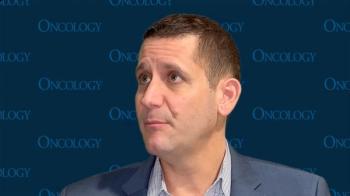
Mitigating ILD Following T-DXd in HR+, HER2-Low Metastatic Breast Cancer
Paolo Tarantino, MD, highlights strategies related to screening and multidisciplinary collaboration for managing ILD in patients who receive T-DXd.
In a conversation with CancerNetwork®, Paolo Tarantino, MD, discussed strategies for mitigating interstitial lung disease (ILD) in patients with hormone receptor–positive, HER2-low or HER2-ultralow metastatic breast cancer who receive fam-trastuzumab deruxtecan-nxki (T-DXd; Enhertu).
Tarantino, a clinical research fellow at Dana-Farber Cancer Institute and Harvard Medical School, spoke about this toxicity in the context of findings from the phase 3 DESTINY-Breast06 trial (NCT04494425) presented at the
When monitoring and managing ILD in patients who receive T-DXd, Tarantino highlighted a variety of procedures such as multidisciplinary collaboration with radiologists and pulmonologists as well as management with steroids.
Transcript:
I will say that that DESTINY-Breast06 confirmed what we must know about the safety profile of T-DXd and physician’s choice of chemotherapy. One important thing is that there were still 3 cases of grade 5 fatal interstitial lung disease [ILD] in DESTINY-Breast06. It’s hard to completely get rid of those [toxicities]. It’s hard to be sure that we’re not going to see any more fatal ILD.
It’s important to keep the awareness on this [adverse] effect. We try to recommend the "Five S’s" that I found helpful to understand how to monitor and manage ILD with T-DXd. The first S is screening for the patient who you have in front of you to understand what the baseline risk is. The second [S] is remembering to scan the patients with CT scans every 6 to 12 weeks, and then [the third S is] synergy with the radiologist, pulmonologist, and the care team in order to manage ILD. [The fourth S is] suspending the drug, T-DXd, whenever ILD is suspected. [The fifth S is] introducing steroids. Those are the five S’s, and it’s very important; it can help to manage ILD.
With that said, most of the other [adverse] effects of T-DXd were very similar to what we knew. Cardiotoxicity was slightly higher in incidence; it was 8% compared with 5% or less in other trials. We know that it’s reversible, and we know that it’s low-grade, so it’s not a major concern. I do feel that we are learning how to use these drugs better. It’s always important to discuss the management of the [adverse] effects and also to develop trials to mitigate the [adverse] effects of antibody drug conjugates [ADCs]. I hope we’ll be able to develop some of these trials to mitigate ILD and maybe even other [adverse] effects with T-DXd.
Reference
Curigliano G, Hu X, Dent RA, et al. Trastuzumab deruxtecan (T-DXd) vs physician’s choice of chemotherapy (TPC) in patients (pts) with hormone receptor-positive (HR+), human epidermal growth factor receptor 2 (HER2)-low or HER2-ultralow metastatic breast cancer (mBC) with prior endocrine therapy (ET): primary results from DESTINY-Breast06 (DB-06). J Clin Oncol. 2024;42(suppl 17):LBA1000. doi:10.1200/JCO.2024.42.17_suppl.LBA1000
Newsletter
Stay up to date on recent advances in the multidisciplinary approach to cancer.

















































































